Report: Identifying and Implementing Training and Coaching
VerifiedAdded on 2023/01/12
|9
|2775
|97
Report
AI Summary
This report delves into the crucial aspects of training and coaching within the workplace, providing a comprehensive overview of how to identify training and coaching needs for individuals. It explores appropriate training techniques, emphasizing the importance of understanding different learning styles to enhance the effectiveness of training programs. The report outlines methods for evaluating training and coaching effectiveness, including the use of the Kauffman's model and questionnaires, and emphasizes the significance of maintaining training records. Furthermore, it discusses how to plan coaching sessions, the role of feedback in coaching, and strategies for evaluating the impact of coaching initiatives on employee performance. The report underscores the benefits of both training and coaching in improving employee skills, boosting productivity, and achieving organizational goals.
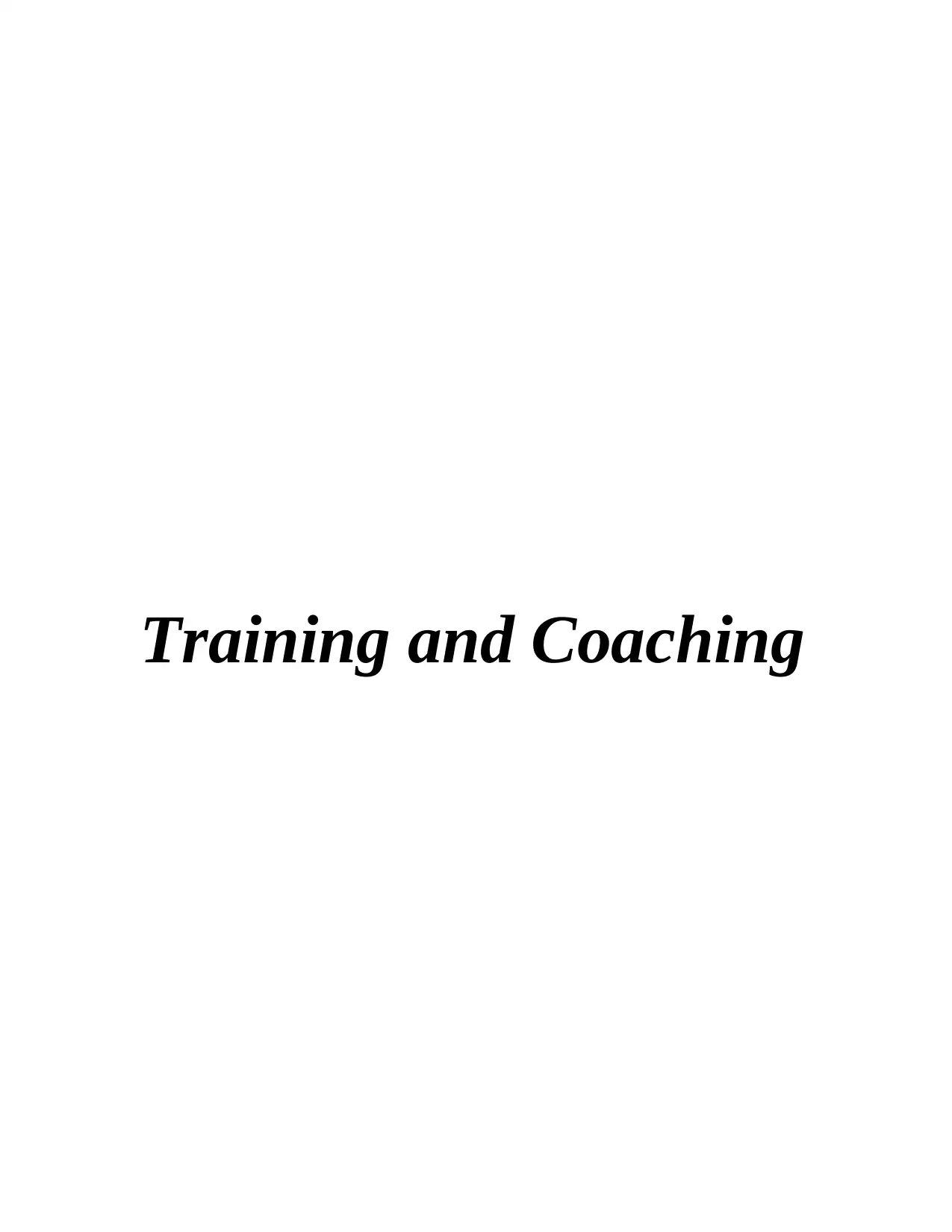
Training and Coaching
Paraphrase This Document
Need a fresh take? Get an instant paraphrase of this document with our AI Paraphraser
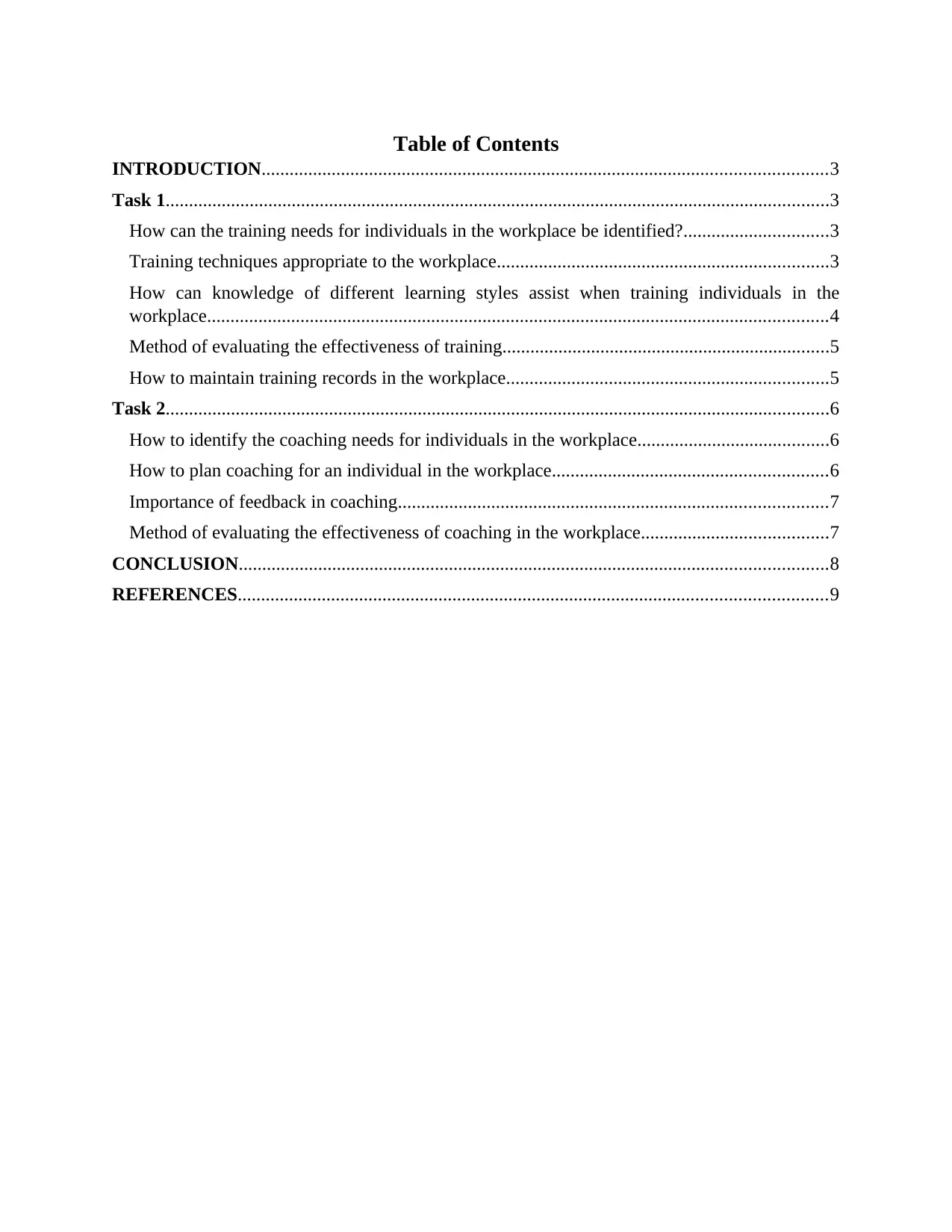
Table of Contents
INTRODUCTION.........................................................................................................................3
Task 1..............................................................................................................................................3
How can the training needs for individuals in the workplace be identified?...............................3
Training techniques appropriate to the workplace.......................................................................3
How can knowledge of different learning styles assist when training individuals in the
workplace.....................................................................................................................................4
Method of evaluating the effectiveness of training......................................................................5
How to maintain training records in the workplace.....................................................................5
Task 2..............................................................................................................................................6
How to identify the coaching needs for individuals in the workplace.........................................6
How to plan coaching for an individual in the workplace...........................................................6
Importance of feedback in coaching............................................................................................7
Method of evaluating the effectiveness of coaching in the workplace........................................7
CONCLUSION..............................................................................................................................8
REFERENCES..............................................................................................................................9
INTRODUCTION.........................................................................................................................3
Task 1..............................................................................................................................................3
How can the training needs for individuals in the workplace be identified?...............................3
Training techniques appropriate to the workplace.......................................................................3
How can knowledge of different learning styles assist when training individuals in the
workplace.....................................................................................................................................4
Method of evaluating the effectiveness of training......................................................................5
How to maintain training records in the workplace.....................................................................5
Task 2..............................................................................................................................................6
How to identify the coaching needs for individuals in the workplace.........................................6
How to plan coaching for an individual in the workplace...........................................................6
Importance of feedback in coaching............................................................................................7
Method of evaluating the effectiveness of coaching in the workplace........................................7
CONCLUSION..............................................................................................................................8
REFERENCES..............................................................................................................................9
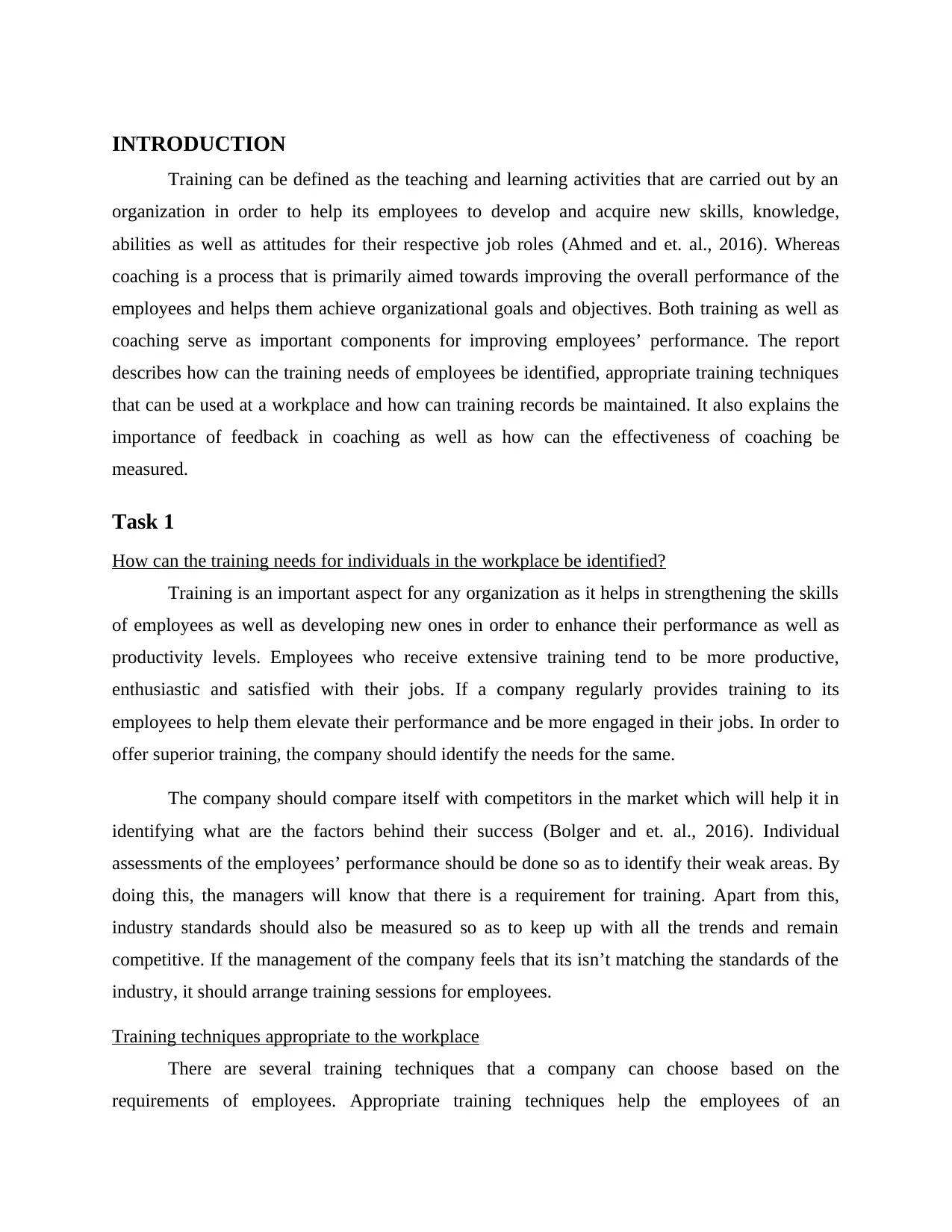
INTRODUCTION
Training can be defined as the teaching and learning activities that are carried out by an
organization in order to help its employees to develop and acquire new skills, knowledge,
abilities as well as attitudes for their respective job roles (Ahmed and et. al., 2016). Whereas
coaching is a process that is primarily aimed towards improving the overall performance of the
employees and helps them achieve organizational goals and objectives. Both training as well as
coaching serve as important components for improving employees’ performance. The report
describes how can the training needs of employees be identified, appropriate training techniques
that can be used at a workplace and how can training records be maintained. It also explains the
importance of feedback in coaching as well as how can the effectiveness of coaching be
measured.
Task 1
How can the training needs for individuals in the workplace be identified?
Training is an important aspect for any organization as it helps in strengthening the skills
of employees as well as developing new ones in order to enhance their performance as well as
productivity levels. Employees who receive extensive training tend to be more productive,
enthusiastic and satisfied with their jobs. If a company regularly provides training to its
employees to help them elevate their performance and be more engaged in their jobs. In order to
offer superior training, the company should identify the needs for the same.
The company should compare itself with competitors in the market which will help it in
identifying what are the factors behind their success (Bolger and et. al., 2016). Individual
assessments of the employees’ performance should be done so as to identify their weak areas. By
doing this, the managers will know that there is a requirement for training. Apart from this,
industry standards should also be measured so as to keep up with all the trends and remain
competitive. If the management of the company feels that its isn’t matching the standards of the
industry, it should arrange training sessions for employees.
Training techniques appropriate to the workplace
There are several training techniques that a company can choose based on the
requirements of employees. Appropriate training techniques help the employees of an
Training can be defined as the teaching and learning activities that are carried out by an
organization in order to help its employees to develop and acquire new skills, knowledge,
abilities as well as attitudes for their respective job roles (Ahmed and et. al., 2016). Whereas
coaching is a process that is primarily aimed towards improving the overall performance of the
employees and helps them achieve organizational goals and objectives. Both training as well as
coaching serve as important components for improving employees’ performance. The report
describes how can the training needs of employees be identified, appropriate training techniques
that can be used at a workplace and how can training records be maintained. It also explains the
importance of feedback in coaching as well as how can the effectiveness of coaching be
measured.
Task 1
How can the training needs for individuals in the workplace be identified?
Training is an important aspect for any organization as it helps in strengthening the skills
of employees as well as developing new ones in order to enhance their performance as well as
productivity levels. Employees who receive extensive training tend to be more productive,
enthusiastic and satisfied with their jobs. If a company regularly provides training to its
employees to help them elevate their performance and be more engaged in their jobs. In order to
offer superior training, the company should identify the needs for the same.
The company should compare itself with competitors in the market which will help it in
identifying what are the factors behind their success (Bolger and et. al., 2016). Individual
assessments of the employees’ performance should be done so as to identify their weak areas. By
doing this, the managers will know that there is a requirement for training. Apart from this,
industry standards should also be measured so as to keep up with all the trends and remain
competitive. If the management of the company feels that its isn’t matching the standards of the
industry, it should arrange training sessions for employees.
Training techniques appropriate to the workplace
There are several training techniques that a company can choose based on the
requirements of employees. Appropriate training techniques help the employees of an
⊘ This is a preview!⊘
Do you want full access?
Subscribe today to unlock all pages.

Trusted by 1+ million students worldwide
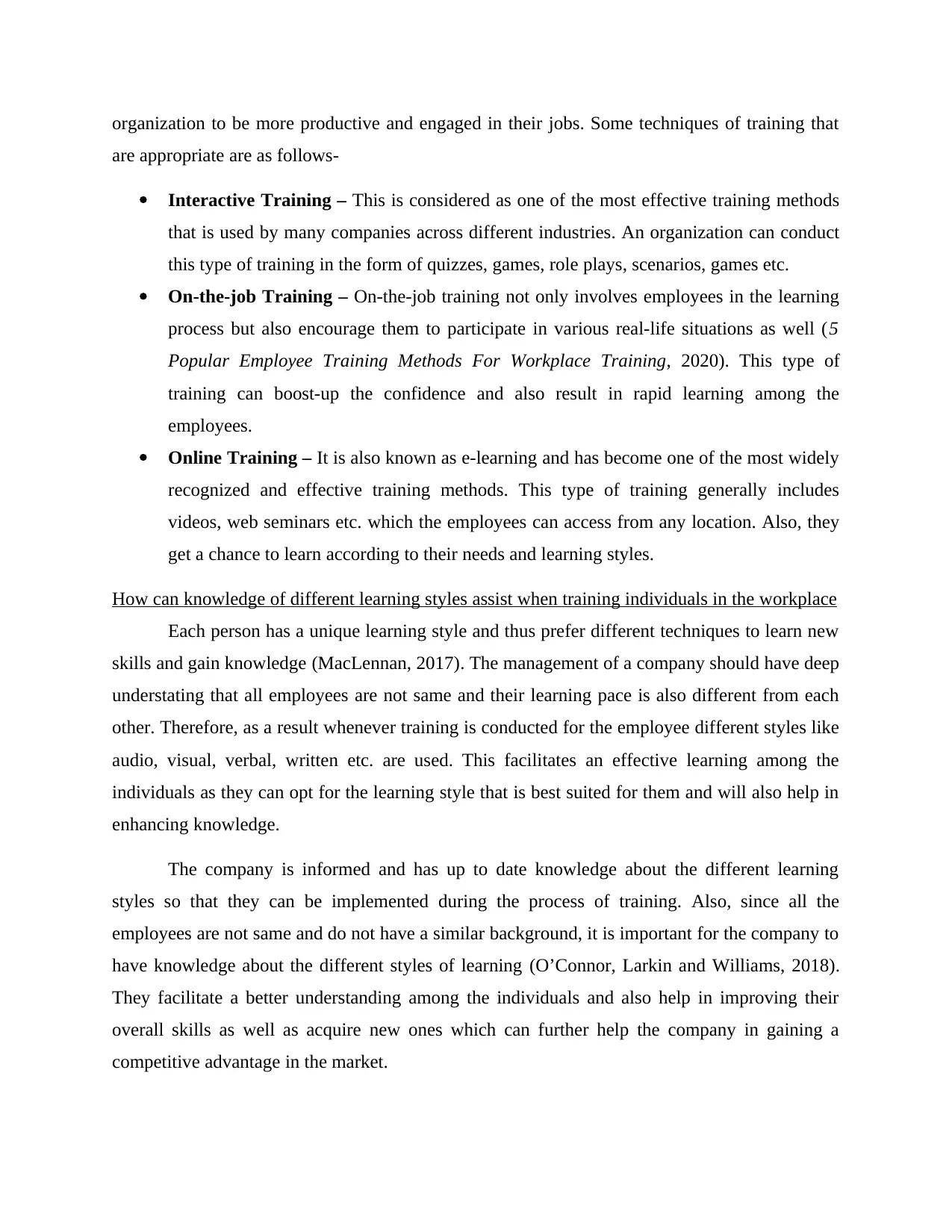
organization to be more productive and engaged in their jobs. Some techniques of training that
are appropriate are as follows-
Interactive Training – This is considered as one of the most effective training methods
that is used by many companies across different industries. An organization can conduct
this type of training in the form of quizzes, games, role plays, scenarios, games etc.
On-the-job Training – On-the-job training not only involves employees in the learning
process but also encourage them to participate in various real-life situations as well (5
Popular Employee Training Methods For Workplace Training, 2020). This type of
training can boost-up the confidence and also result in rapid learning among the
employees.
Online Training – It is also known as e-learning and has become one of the most widely
recognized and effective training methods. This type of training generally includes
videos, web seminars etc. which the employees can access from any location. Also, they
get a chance to learn according to their needs and learning styles.
How can knowledge of different learning styles assist when training individuals in the workplace
Each person has a unique learning style and thus prefer different techniques to learn new
skills and gain knowledge (MacLennan, 2017). The management of a company should have deep
understating that all employees are not same and their learning pace is also different from each
other. Therefore, as a result whenever training is conducted for the employee different styles like
audio, visual, verbal, written etc. are used. This facilitates an effective learning among the
individuals as they can opt for the learning style that is best suited for them and will also help in
enhancing knowledge.
The company is informed and has up to date knowledge about the different learning
styles so that they can be implemented during the process of training. Also, since all the
employees are not same and do not have a similar background, it is important for the company to
have knowledge about the different styles of learning (O’Connor, Larkin and Williams, 2018).
They facilitate a better understanding among the individuals and also help in improving their
overall skills as well as acquire new ones which can further help the company in gaining a
competitive advantage in the market.
are appropriate are as follows-
Interactive Training – This is considered as one of the most effective training methods
that is used by many companies across different industries. An organization can conduct
this type of training in the form of quizzes, games, role plays, scenarios, games etc.
On-the-job Training – On-the-job training not only involves employees in the learning
process but also encourage them to participate in various real-life situations as well (5
Popular Employee Training Methods For Workplace Training, 2020). This type of
training can boost-up the confidence and also result in rapid learning among the
employees.
Online Training – It is also known as e-learning and has become one of the most widely
recognized and effective training methods. This type of training generally includes
videos, web seminars etc. which the employees can access from any location. Also, they
get a chance to learn according to their needs and learning styles.
How can knowledge of different learning styles assist when training individuals in the workplace
Each person has a unique learning style and thus prefer different techniques to learn new
skills and gain knowledge (MacLennan, 2017). The management of a company should have deep
understating that all employees are not same and their learning pace is also different from each
other. Therefore, as a result whenever training is conducted for the employee different styles like
audio, visual, verbal, written etc. are used. This facilitates an effective learning among the
individuals as they can opt for the learning style that is best suited for them and will also help in
enhancing knowledge.
The company is informed and has up to date knowledge about the different learning
styles so that they can be implemented during the process of training. Also, since all the
employees are not same and do not have a similar background, it is important for the company to
have knowledge about the different styles of learning (O’Connor, Larkin and Williams, 2018).
They facilitate a better understanding among the individuals and also help in improving their
overall skills as well as acquire new ones which can further help the company in gaining a
competitive advantage in the market.
Paraphrase This Document
Need a fresh take? Get an instant paraphrase of this document with our AI Paraphraser
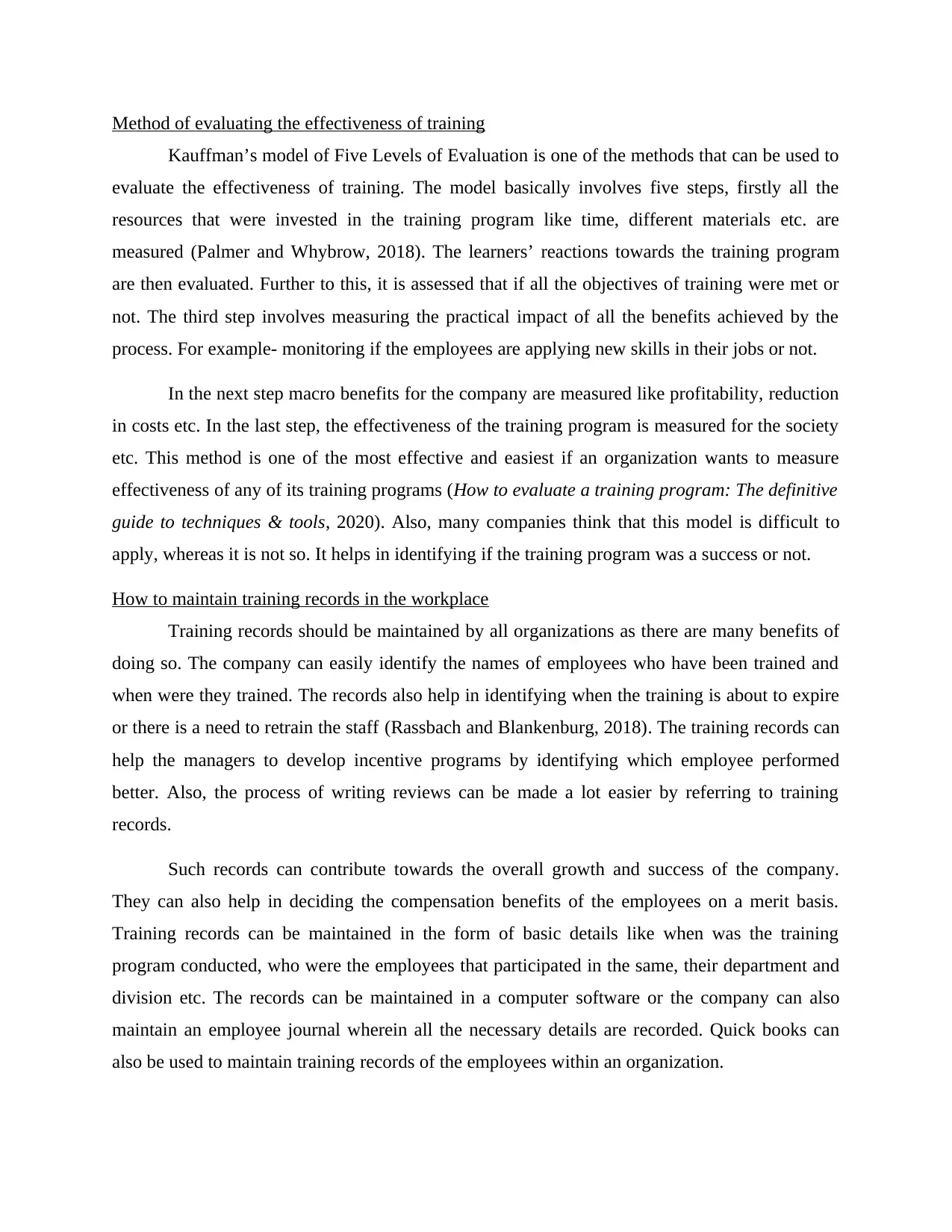
Method of evaluating the effectiveness of training
Kauffman’s model of Five Levels of Evaluation is one of the methods that can be used to
evaluate the effectiveness of training. The model basically involves five steps, firstly all the
resources that were invested in the training program like time, different materials etc. are
measured (Palmer and Whybrow, 2018). The learners’ reactions towards the training program
are then evaluated. Further to this, it is assessed that if all the objectives of training were met or
not. The third step involves measuring the practical impact of all the benefits achieved by the
process. For example- monitoring if the employees are applying new skills in their jobs or not.
In the next step macro benefits for the company are measured like profitability, reduction
in costs etc. In the last step, the effectiveness of the training program is measured for the society
etc. This method is one of the most effective and easiest if an organization wants to measure
effectiveness of any of its training programs (How to evaluate a training program: The definitive
guide to techniques & tools, 2020). Also, many companies think that this model is difficult to
apply, whereas it is not so. It helps in identifying if the training program was a success or not.
How to maintain training records in the workplace
Training records should be maintained by all organizations as there are many benefits of
doing so. The company can easily identify the names of employees who have been trained and
when were they trained. The records also help in identifying when the training is about to expire
or there is a need to retrain the staff (Rassbach and Blankenburg, 2018). The training records can
help the managers to develop incentive programs by identifying which employee performed
better. Also, the process of writing reviews can be made a lot easier by referring to training
records.
Such records can contribute towards the overall growth and success of the company.
They can also help in deciding the compensation benefits of the employees on a merit basis.
Training records can be maintained in the form of basic details like when was the training
program conducted, who were the employees that participated in the same, their department and
division etc. The records can be maintained in a computer software or the company can also
maintain an employee journal wherein all the necessary details are recorded. Quick books can
also be used to maintain training records of the employees within an organization.
Kauffman’s model of Five Levels of Evaluation is one of the methods that can be used to
evaluate the effectiveness of training. The model basically involves five steps, firstly all the
resources that were invested in the training program like time, different materials etc. are
measured (Palmer and Whybrow, 2018). The learners’ reactions towards the training program
are then evaluated. Further to this, it is assessed that if all the objectives of training were met or
not. The third step involves measuring the practical impact of all the benefits achieved by the
process. For example- monitoring if the employees are applying new skills in their jobs or not.
In the next step macro benefits for the company are measured like profitability, reduction
in costs etc. In the last step, the effectiveness of the training program is measured for the society
etc. This method is one of the most effective and easiest if an organization wants to measure
effectiveness of any of its training programs (How to evaluate a training program: The definitive
guide to techniques & tools, 2020). Also, many companies think that this model is difficult to
apply, whereas it is not so. It helps in identifying if the training program was a success or not.
How to maintain training records in the workplace
Training records should be maintained by all organizations as there are many benefits of
doing so. The company can easily identify the names of employees who have been trained and
when were they trained. The records also help in identifying when the training is about to expire
or there is a need to retrain the staff (Rassbach and Blankenburg, 2018). The training records can
help the managers to develop incentive programs by identifying which employee performed
better. Also, the process of writing reviews can be made a lot easier by referring to training
records.
Such records can contribute towards the overall growth and success of the company.
They can also help in deciding the compensation benefits of the employees on a merit basis.
Training records can be maintained in the form of basic details like when was the training
program conducted, who were the employees that participated in the same, their department and
division etc. The records can be maintained in a computer software or the company can also
maintain an employee journal wherein all the necessary details are recorded. Quick books can
also be used to maintain training records of the employees within an organization.
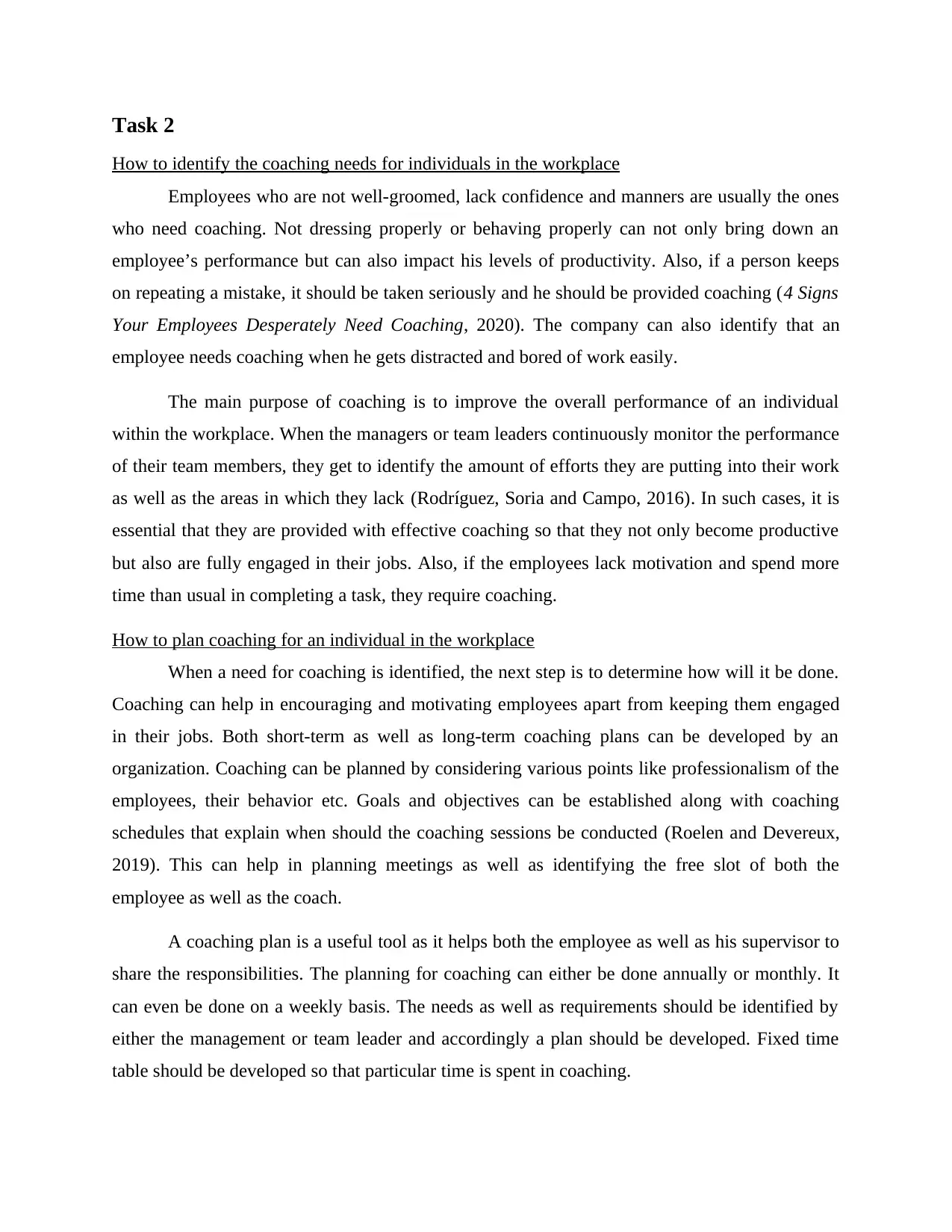
Task 2
How to identify the coaching needs for individuals in the workplace
Employees who are not well-groomed, lack confidence and manners are usually the ones
who need coaching. Not dressing properly or behaving properly can not only bring down an
employee’s performance but can also impact his levels of productivity. Also, if a person keeps
on repeating a mistake, it should be taken seriously and he should be provided coaching (4 Signs
Your Employees Desperately Need Coaching, 2020). The company can also identify that an
employee needs coaching when he gets distracted and bored of work easily.
The main purpose of coaching is to improve the overall performance of an individual
within the workplace. When the managers or team leaders continuously monitor the performance
of their team members, they get to identify the amount of efforts they are putting into their work
as well as the areas in which they lack (Rodríguez, Soria and Campo, 2016). In such cases, it is
essential that they are provided with effective coaching so that they not only become productive
but also are fully engaged in their jobs. Also, if the employees lack motivation and spend more
time than usual in completing a task, they require coaching.
How to plan coaching for an individual in the workplace
When a need for coaching is identified, the next step is to determine how will it be done.
Coaching can help in encouraging and motivating employees apart from keeping them engaged
in their jobs. Both short-term as well as long-term coaching plans can be developed by an
organization. Coaching can be planned by considering various points like professionalism of the
employees, their behavior etc. Goals and objectives can be established along with coaching
schedules that explain when should the coaching sessions be conducted (Roelen and Devereux,
2019). This can help in planning meetings as well as identifying the free slot of both the
employee as well as the coach.
A coaching plan is a useful tool as it helps both the employee as well as his supervisor to
share the responsibilities. The planning for coaching can either be done annually or monthly. It
can even be done on a weekly basis. The needs as well as requirements should be identified by
either the management or team leader and accordingly a plan should be developed. Fixed time
table should be developed so that particular time is spent in coaching.
How to identify the coaching needs for individuals in the workplace
Employees who are not well-groomed, lack confidence and manners are usually the ones
who need coaching. Not dressing properly or behaving properly can not only bring down an
employee’s performance but can also impact his levels of productivity. Also, if a person keeps
on repeating a mistake, it should be taken seriously and he should be provided coaching (4 Signs
Your Employees Desperately Need Coaching, 2020). The company can also identify that an
employee needs coaching when he gets distracted and bored of work easily.
The main purpose of coaching is to improve the overall performance of an individual
within the workplace. When the managers or team leaders continuously monitor the performance
of their team members, they get to identify the amount of efforts they are putting into their work
as well as the areas in which they lack (Rodríguez, Soria and Campo, 2016). In such cases, it is
essential that they are provided with effective coaching so that they not only become productive
but also are fully engaged in their jobs. Also, if the employees lack motivation and spend more
time than usual in completing a task, they require coaching.
How to plan coaching for an individual in the workplace
When a need for coaching is identified, the next step is to determine how will it be done.
Coaching can help in encouraging and motivating employees apart from keeping them engaged
in their jobs. Both short-term as well as long-term coaching plans can be developed by an
organization. Coaching can be planned by considering various points like professionalism of the
employees, their behavior etc. Goals and objectives can be established along with coaching
schedules that explain when should the coaching sessions be conducted (Roelen and Devereux,
2019). This can help in planning meetings as well as identifying the free slot of both the
employee as well as the coach.
A coaching plan is a useful tool as it helps both the employee as well as his supervisor to
share the responsibilities. The planning for coaching can either be done annually or monthly. It
can even be done on a weekly basis. The needs as well as requirements should be identified by
either the management or team leader and accordingly a plan should be developed. Fixed time
table should be developed so that particular time is spent in coaching.
⊘ This is a preview!⊘
Do you want full access?
Subscribe today to unlock all pages.

Trusted by 1+ million students worldwide
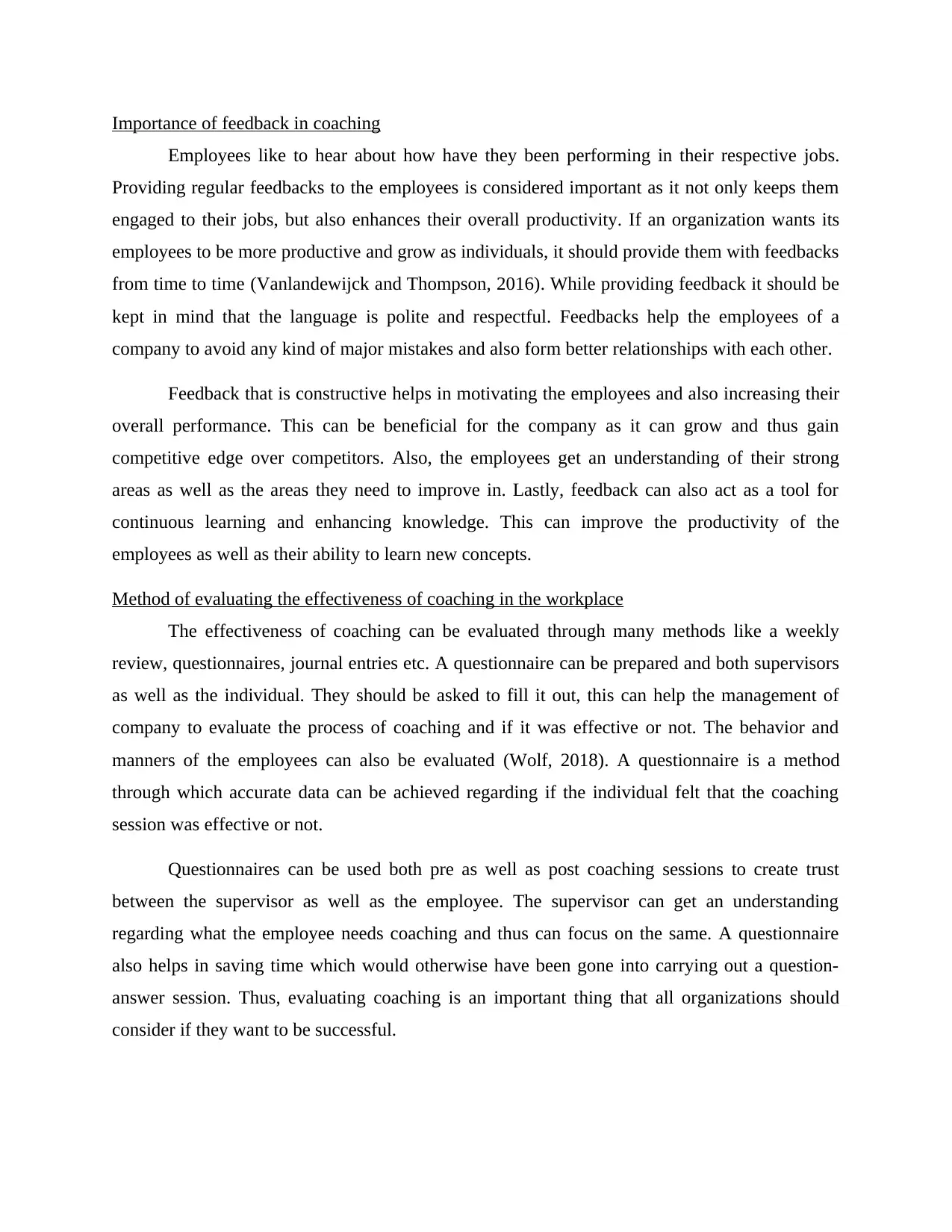
Importance of feedback in coaching
Employees like to hear about how have they been performing in their respective jobs.
Providing regular feedbacks to the employees is considered important as it not only keeps them
engaged to their jobs, but also enhances their overall productivity. If an organization wants its
employees to be more productive and grow as individuals, it should provide them with feedbacks
from time to time (Vanlandewijck and Thompson, 2016). While providing feedback it should be
kept in mind that the language is polite and respectful. Feedbacks help the employees of a
company to avoid any kind of major mistakes and also form better relationships with each other.
Feedback that is constructive helps in motivating the employees and also increasing their
overall performance. This can be beneficial for the company as it can grow and thus gain
competitive edge over competitors. Also, the employees get an understanding of their strong
areas as well as the areas they need to improve in. Lastly, feedback can also act as a tool for
continuous learning and enhancing knowledge. This can improve the productivity of the
employees as well as their ability to learn new concepts.
Method of evaluating the effectiveness of coaching in the workplace
The effectiveness of coaching can be evaluated through many methods like a weekly
review, questionnaires, journal entries etc. A questionnaire can be prepared and both supervisors
as well as the individual. They should be asked to fill it out, this can help the management of
company to evaluate the process of coaching and if it was effective or not. The behavior and
manners of the employees can also be evaluated (Wolf, 2018). A questionnaire is a method
through which accurate data can be achieved regarding if the individual felt that the coaching
session was effective or not.
Questionnaires can be used both pre as well as post coaching sessions to create trust
between the supervisor as well as the employee. The supervisor can get an understanding
regarding what the employee needs coaching and thus can focus on the same. A questionnaire
also helps in saving time which would otherwise have been gone into carrying out a question-
answer session. Thus, evaluating coaching is an important thing that all organizations should
consider if they want to be successful.
Employees like to hear about how have they been performing in their respective jobs.
Providing regular feedbacks to the employees is considered important as it not only keeps them
engaged to their jobs, but also enhances their overall productivity. If an organization wants its
employees to be more productive and grow as individuals, it should provide them with feedbacks
from time to time (Vanlandewijck and Thompson, 2016). While providing feedback it should be
kept in mind that the language is polite and respectful. Feedbacks help the employees of a
company to avoid any kind of major mistakes and also form better relationships with each other.
Feedback that is constructive helps in motivating the employees and also increasing their
overall performance. This can be beneficial for the company as it can grow and thus gain
competitive edge over competitors. Also, the employees get an understanding of their strong
areas as well as the areas they need to improve in. Lastly, feedback can also act as a tool for
continuous learning and enhancing knowledge. This can improve the productivity of the
employees as well as their ability to learn new concepts.
Method of evaluating the effectiveness of coaching in the workplace
The effectiveness of coaching can be evaluated through many methods like a weekly
review, questionnaires, journal entries etc. A questionnaire can be prepared and both supervisors
as well as the individual. They should be asked to fill it out, this can help the management of
company to evaluate the process of coaching and if it was effective or not. The behavior and
manners of the employees can also be evaluated (Wolf, 2018). A questionnaire is a method
through which accurate data can be achieved regarding if the individual felt that the coaching
session was effective or not.
Questionnaires can be used both pre as well as post coaching sessions to create trust
between the supervisor as well as the employee. The supervisor can get an understanding
regarding what the employee needs coaching and thus can focus on the same. A questionnaire
also helps in saving time which would otherwise have been gone into carrying out a question-
answer session. Thus, evaluating coaching is an important thing that all organizations should
consider if they want to be successful.
Paraphrase This Document
Need a fresh take? Get an instant paraphrase of this document with our AI Paraphraser
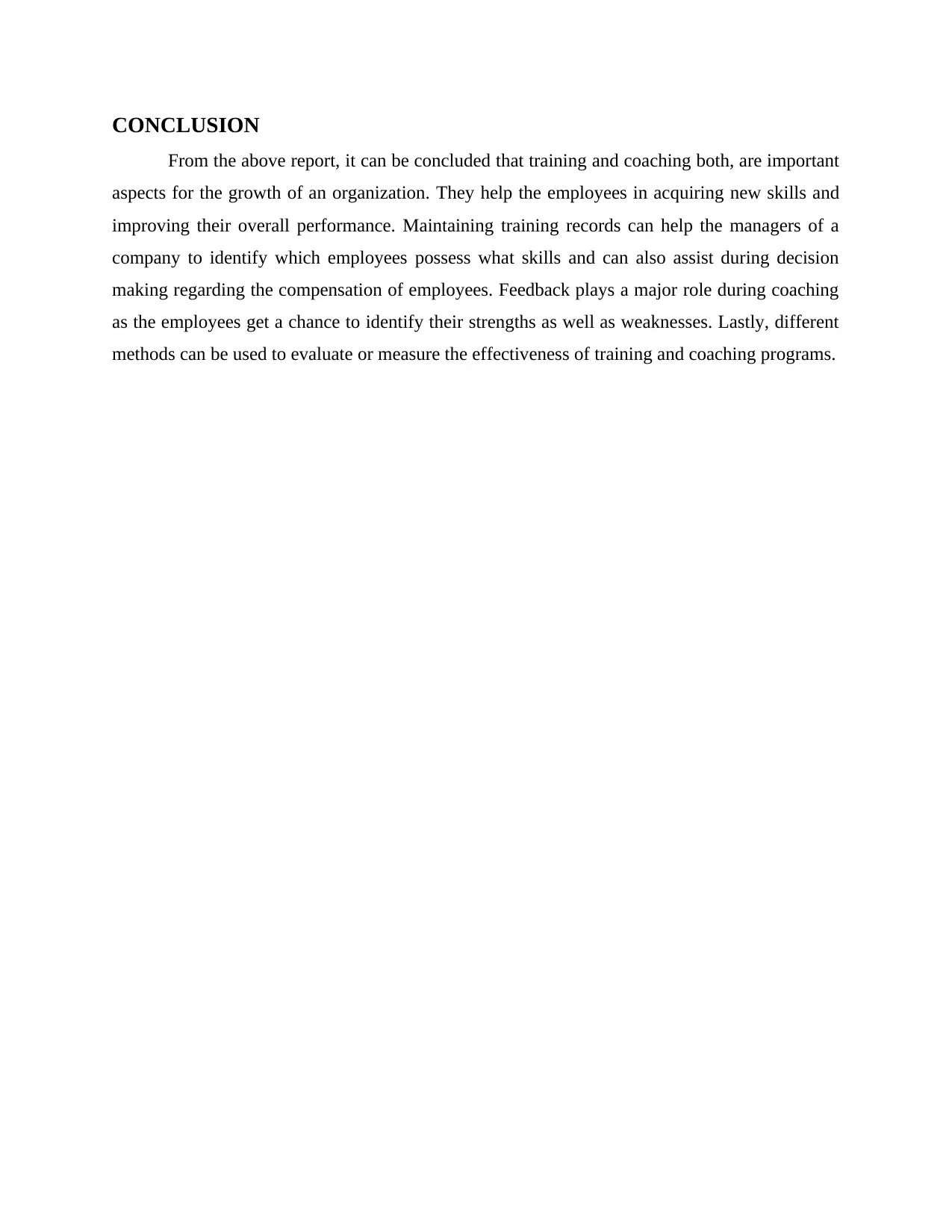
CONCLUSION
From the above report, it can be concluded that training and coaching both, are important
aspects for the growth of an organization. They help the employees in acquiring new skills and
improving their overall performance. Maintaining training records can help the managers of a
company to identify which employees possess what skills and can also assist during decision
making regarding the compensation of employees. Feedback plays a major role during coaching
as the employees get a chance to identify their strengths as well as weaknesses. Lastly, different
methods can be used to evaluate or measure the effectiveness of training and coaching programs.
From the above report, it can be concluded that training and coaching both, are important
aspects for the growth of an organization. They help the employees in acquiring new skills and
improving their overall performance. Maintaining training records can help the managers of a
company to identify which employees possess what skills and can also assist during decision
making regarding the compensation of employees. Feedback plays a major role during coaching
as the employees get a chance to identify their strengths as well as weaknesses. Lastly, different
methods can be used to evaluate or measure the effectiveness of training and coaching programs.
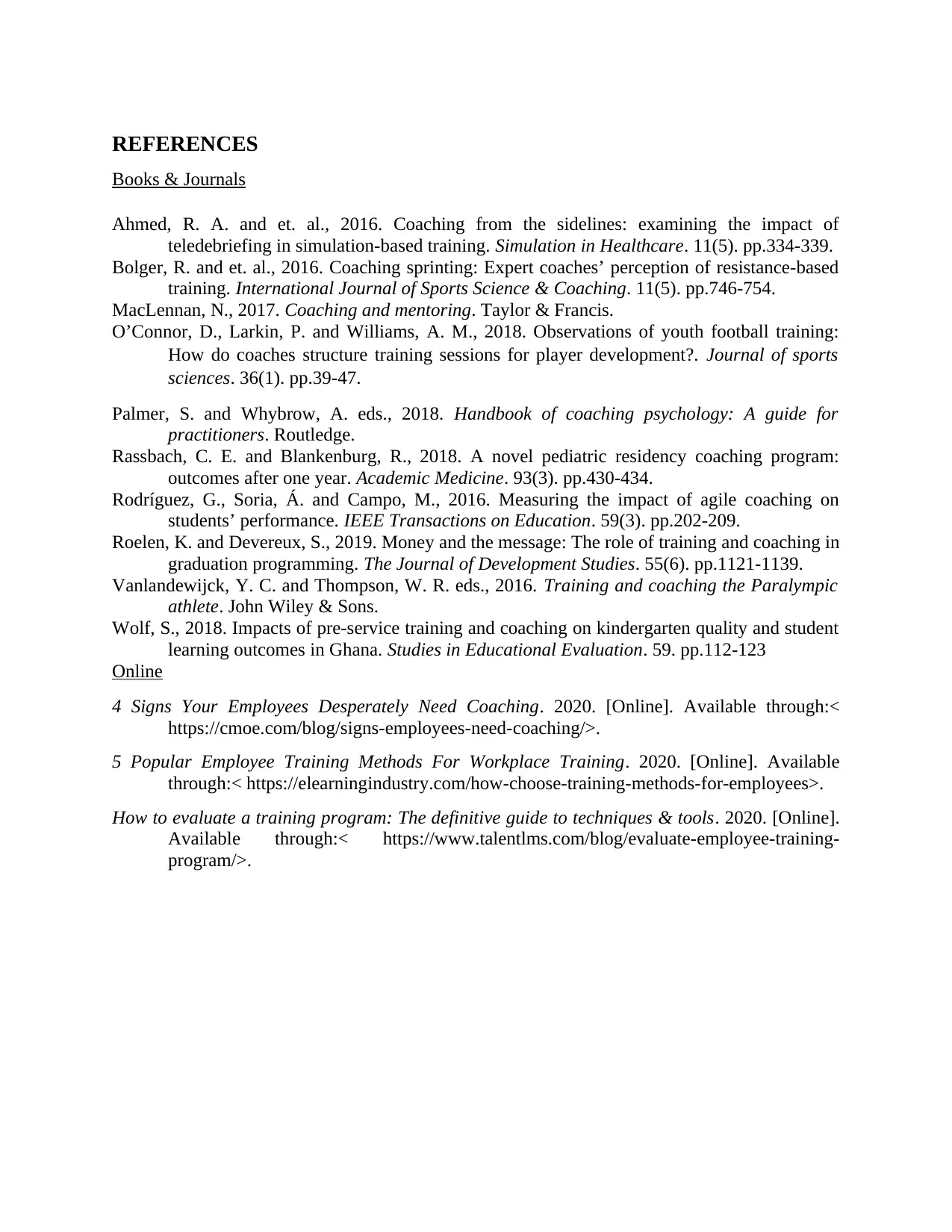
REFERENCES
Books & Journals
Ahmed, R. A. and et. al., 2016. Coaching from the sidelines: examining the impact of
teledebriefing in simulation-based training. Simulation in Healthcare. 11(5). pp.334-339.
Bolger, R. and et. al., 2016. Coaching sprinting: Expert coaches’ perception of resistance-based
training. International Journal of Sports Science & Coaching. 11(5). pp.746-754.
MacLennan, N., 2017. Coaching and mentoring. Taylor & Francis.
O’Connor, D., Larkin, P. and Williams, A. M., 2018. Observations of youth football training:
How do coaches structure training sessions for player development?. Journal of sports
sciences. 36(1). pp.39-47.
Palmer, S. and Whybrow, A. eds., 2018. Handbook of coaching psychology: A guide for
practitioners. Routledge.
Rassbach, C. E. and Blankenburg, R., 2018. A novel pediatric residency coaching program:
outcomes after one year. Academic Medicine. 93(3). pp.430-434.
Rodríguez, G., Soria, Á. and Campo, M., 2016. Measuring the impact of agile coaching on
students’ performance. IEEE Transactions on Education. 59(3). pp.202-209.
Roelen, K. and Devereux, S., 2019. Money and the message: The role of training and coaching in
graduation programming. The Journal of Development Studies. 55(6). pp.1121-1139.
Vanlandewijck, Y. C. and Thompson, W. R. eds., 2016. Training and coaching the Paralympic
athlete. John Wiley & Sons.
Wolf, S., 2018. Impacts of pre-service training and coaching on kindergarten quality and student
learning outcomes in Ghana. Studies in Educational Evaluation. 59. pp.112-123
Online
4 Signs Your Employees Desperately Need Coaching. 2020. [Online]. Available through:<
https://cmoe.com/blog/signs-employees-need-coaching/>.
5 Popular Employee Training Methods For Workplace Training. 2020. [Online]. Available
through:< https://elearningindustry.com/how-choose-training-methods-for-employees>.
How to evaluate a training program: The definitive guide to techniques & tools. 2020. [Online].
Available through:< https://www.talentlms.com/blog/evaluate-employee-training-
program/>.
Books & Journals
Ahmed, R. A. and et. al., 2016. Coaching from the sidelines: examining the impact of
teledebriefing in simulation-based training. Simulation in Healthcare. 11(5). pp.334-339.
Bolger, R. and et. al., 2016. Coaching sprinting: Expert coaches’ perception of resistance-based
training. International Journal of Sports Science & Coaching. 11(5). pp.746-754.
MacLennan, N., 2017. Coaching and mentoring. Taylor & Francis.
O’Connor, D., Larkin, P. and Williams, A. M., 2018. Observations of youth football training:
How do coaches structure training sessions for player development?. Journal of sports
sciences. 36(1). pp.39-47.
Palmer, S. and Whybrow, A. eds., 2018. Handbook of coaching psychology: A guide for
practitioners. Routledge.
Rassbach, C. E. and Blankenburg, R., 2018. A novel pediatric residency coaching program:
outcomes after one year. Academic Medicine. 93(3). pp.430-434.
Rodríguez, G., Soria, Á. and Campo, M., 2016. Measuring the impact of agile coaching on
students’ performance. IEEE Transactions on Education. 59(3). pp.202-209.
Roelen, K. and Devereux, S., 2019. Money and the message: The role of training and coaching in
graduation programming. The Journal of Development Studies. 55(6). pp.1121-1139.
Vanlandewijck, Y. C. and Thompson, W. R. eds., 2016. Training and coaching the Paralympic
athlete. John Wiley & Sons.
Wolf, S., 2018. Impacts of pre-service training and coaching on kindergarten quality and student
learning outcomes in Ghana. Studies in Educational Evaluation. 59. pp.112-123
Online
4 Signs Your Employees Desperately Need Coaching. 2020. [Online]. Available through:<
https://cmoe.com/blog/signs-employees-need-coaching/>.
5 Popular Employee Training Methods For Workplace Training. 2020. [Online]. Available
through:< https://elearningindustry.com/how-choose-training-methods-for-employees>.
How to evaluate a training program: The definitive guide to techniques & tools. 2020. [Online].
Available through:< https://www.talentlms.com/blog/evaluate-employee-training-
program/>.
⊘ This is a preview!⊘
Do you want full access?
Subscribe today to unlock all pages.

Trusted by 1+ million students worldwide
1 out of 9
Related Documents
Your All-in-One AI-Powered Toolkit for Academic Success.
+13062052269
info@desklib.com
Available 24*7 on WhatsApp / Email
![[object Object]](/_next/static/media/star-bottom.7253800d.svg)
Unlock your academic potential
Copyright © 2020–2025 A2Z Services. All Rights Reserved. Developed and managed by ZUCOL.




